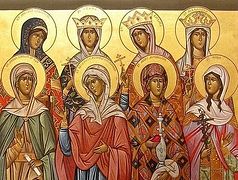When we think about the Myrrhbearing Women going to the tomb of Christ on that first Day of the Lord, we should not romanticize about the tomb of Christ. These Holy Women Disciples of the Lord are not on their way to see if Jesus has risen – the resurrection is far from their minds because it formed no part of their experience of life. They are on their way to pour funeral oils on a decomposing corpse. Tombs for them were a bottomless pit into which the dead were placed never to be seen or heard from again. Tombs were nothing but the entrance way into Hades, Sheol, that place of the dead.
Their Scriptures had taught them that death, the grave and Sheol all have an insatiable appetite – consuming every human being and always hungry to swallow more (See Numbers 16:30-33; Job 7:9; Psalm 89:48; Proverbs 27:20, 30:15-16; Isaiah 5:14; Habakkuk 2:5). Hades was a prison from which there was no escape. It was a gulag from which no one returned alive. The tombs were the all consuming mouth which was the entrance to the belly of Sheol. It was a mouth always open, always ready to devour more people. Sheol is never full, nor even half full for it is an endless abyss into which humanity falls.
And it was into this gaping mouth that the body of the Lord was placed. One more victim swallowed up by death’s insatiable appetite.
The tombs were a symbol of God’s creation gone awry. They reminded everyone that there were forces at work in the world over which they had no control. The tombs reminded everyone that wealth and beauty are fleeting – they last only a short while, and you can’t take it with you. The women going to the tomb of Christ knew how fragile life is for they already had many friends and family members in the tombs, in the bottomless pit of the belly of Sheol.
Jesus himself had said: “Woe to you, scribes and Pharisees, hypocrites! for you are like whitewashed tombs, which outwardly appear beautiful, but within they are full of dead men’s bones and all uncleanness.” (Matthew 23:27)
You could decorate the tombs and make them look quite beautiful, but they still contained rotting flesh and the bones which are all that remain of the dead.
So we remember the Holy Myrrhbearing Women, those saints of our church who were the first to hear of the resurrection, but who on that first day of the week 2000 years ago were in fact looking for Jesus, but thinking He was nothing but a corpse.
And we can think about our life in the Church today. We too can make beautiful church buildings which are nothing more than the white washed tombs which Jesus criticized. I remember years ago going to the main cathedral of a European city on Easter Sunday and though Easter mass was going on, the building was eerily vacant as few people were attending – the empty tomb had taken on a new meaning.
We have to make our churches full of God’s grace by becoming a living temple (1 Peter 2:5) because we each are alive in Christ. Then people will not come to the church looking for the corpse of Christ, but to receive His resurrected Body. There may be people out there like the Myrrhbearing women who are searching for something, but don’t even realize what they could find in the Church. If we are the tomb of Christ – we need to become that tomb from which life will flow from us, and in which all who die and are buried with Christ in baptism will also be raised with Him to eternal life. We have to be true witnesses to Christ and live for the Kingdom of God, not for this world, live as if we actually believed in the life of the world to come.
The Myrrhbearing Women going to the tomb of Christ tell us to consider what we are as church – the empty tomb of the dead? a museum of antiquities? A way to the past? OR, the place where we hear the angels sing, “Christ is risen!” The place where we encounter the Risen Lord, the place where we enter into eternal life. God lives not in buildings, but in our hearts and in our midst. If there is life in our churches, then we should be flocking to them ourselves to be nurtured and nourished in the way of life everlasting. We should be there for prayer, worship, fellowship, bible study, peace making, charity and to do the ministry Christ needs us to do. We should be living the Beatitudes, a light to the world.
And those same women also remind us that not only our church buildings, but our hearts within us can also be either the empty tomb, void of life, or the place where the Risen Christ abides, reigning in our hearts and through us giving life to the world. Our souls, our hearts and minds are also to be beautiful temples for the Lord – the place where the Holy Spirit can dwell on earth to bring forth the fruit of paradise.
The Myrrhbearing Women tell us to look for Christ – we should know Him in our hearts and in our parish congregations. He should be present with us, so that anyone else can see Him in us.






